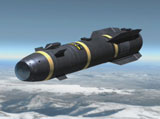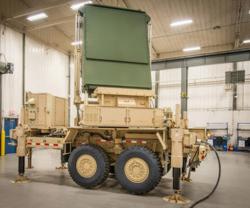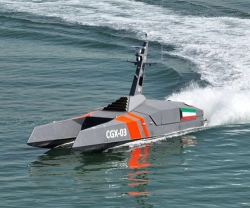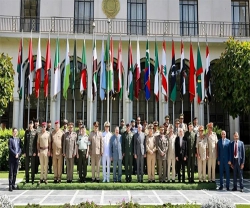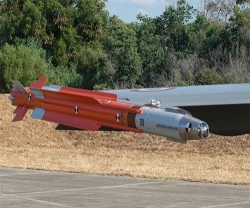Lockheed's Hellfire II to be Deadlier
18.10.2011 Security
A precision-strike missile that has been a star of the US-led war on Al Qaeda and its allies is about to get deadlier, said a Senior Defense Expert.
The cylindrical, 49-kg missile, known as Hellfire II, has been the weapon of choice on remotely piloted aircraft such as the General Atomics MQ-1A Predator and the MQ-9 Reaper.
These drones have been hunting US foes in Afghanistan, Iraq, Yemen, Somalia and Pakistani tribal areas. Among the recent targets of a CIA-operated drone was US-born cleric Anwar al-Awlaki, who was a top US anti-terrorist target until he was killed in northern Yemen on September 30.
Now an even more lethal version of the missile is close to being fielded. It wraps all of the killer applications of previous Hellfire II models into a single warhead for greater operational flexibility, according to its maker, Lockheed Martin Corporation.
"One missile for many missions," said a promotional sheet next to a Lockheed missile mock-up at an annual meeting and arms bazaar of the Association of the United States Army (AUSA), which was held in Washington this past week (10-12 October).
The new missile is designated the AGM-114R, or Hellfire Romeo. Tipped with a "multi-purpose" warhead behind its domed nose, it is designed to knock out "hard, soft and enclosed targets" with a single Hellfire missile load, said Lockheed, the Pentagon's No. 1 supplier by sales.
Lockheed said in March that fielding of the new version had been scheduled for late next year.
Dan O'Boyle, a spokesman for the US Army office that manages Hellfire missile purchases at Redstone Arsenal in Alabama, said: "We look forward to fielding the 'R' model soon." Testing remains under way.
It will provide US forces with safety and reliability improvements as well as the ability to engage multiple target classes with a single missile variant, he added in an email.
The 'R' version's warhead combines the shaped-charge anti-armor capability of the initial anti-tank version with the enhanced effects of fragmentation, blast/fragmentation and heat/blast/overpressure built into later models.
The new version will also be able to be fired at "off-bore" targets for the first time, meaning the aircraft or helicopter does not have to be pointing at the target to acquire it.
Hellfire, a loose acronym for Heliborne, Laser, Fire and Forget, is the primary air-to-ground missile system for the US Armed Forces, the Central Intelligence Agency's paramilitary capabilities and many allied nations.
Like its predecessors, the new missile can be launched from a range of platforms in the air, at sea or on the ground. It uses a designator spot laser that can lock on to its target before or after launch.
Export deliveries of air-launched Hellfire missiles have been made to Australia, Egypt, France, Greece, Iraq, Israel, Japan, Lebanon, South Korea, Kuwait, the Netherlands, Saudi Arabia, Spain, Singapore, Taiwan, Turkey, the UAE and the United Kingdom, according to Jane's Missiles & Rockets yearbook.
Another version has gone to Greece, Israel, Japan, Kuwait and the Netherlands. In 1987, Sweden ordered a coastal defense variant, local designation RBS-17, and Norway ordered similar missiles in 1994, the yearbook said. (Reuters; Jane's Missiles & Rockets Yearbook)
The cylindrical, 49-kg missile, known as Hellfire II, has been the weapon of choice on remotely piloted aircraft such as the General Atomics MQ-1A Predator and the MQ-9 Reaper.
These drones have been hunting US foes in Afghanistan, Iraq, Yemen, Somalia and Pakistani tribal areas. Among the recent targets of a CIA-operated drone was US-born cleric Anwar al-Awlaki, who was a top US anti-terrorist target until he was killed in northern Yemen on September 30.
Now an even more lethal version of the missile is close to being fielded. It wraps all of the killer applications of previous Hellfire II models into a single warhead for greater operational flexibility, according to its maker, Lockheed Martin Corporation.
"One missile for many missions," said a promotional sheet next to a Lockheed missile mock-up at an annual meeting and arms bazaar of the Association of the United States Army (AUSA), which was held in Washington this past week (10-12 October).
The new missile is designated the AGM-114R, or Hellfire Romeo. Tipped with a "multi-purpose" warhead behind its domed nose, it is designed to knock out "hard, soft and enclosed targets" with a single Hellfire missile load, said Lockheed, the Pentagon's No. 1 supplier by sales.
Lockheed said in March that fielding of the new version had been scheduled for late next year.
Dan O'Boyle, a spokesman for the US Army office that manages Hellfire missile purchases at Redstone Arsenal in Alabama, said: "We look forward to fielding the 'R' model soon." Testing remains under way.
It will provide US forces with safety and reliability improvements as well as the ability to engage multiple target classes with a single missile variant, he added in an email.
The 'R' version's warhead combines the shaped-charge anti-armor capability of the initial anti-tank version with the enhanced effects of fragmentation, blast/fragmentation and heat/blast/overpressure built into later models.
The new version will also be able to be fired at "off-bore" targets for the first time, meaning the aircraft or helicopter does not have to be pointing at the target to acquire it.
Hellfire, a loose acronym for Heliborne, Laser, Fire and Forget, is the primary air-to-ground missile system for the US Armed Forces, the Central Intelligence Agency's paramilitary capabilities and many allied nations.
Like its predecessors, the new missile can be launched from a range of platforms in the air, at sea or on the ground. It uses a designator spot laser that can lock on to its target before or after launch.
Export deliveries of air-launched Hellfire missiles have been made to Australia, Egypt, France, Greece, Iraq, Israel, Japan, Lebanon, South Korea, Kuwait, the Netherlands, Saudi Arabia, Spain, Singapore, Taiwan, Turkey, the UAE and the United Kingdom, according to Jane's Missiles & Rockets yearbook.
Another version has gone to Greece, Israel, Japan, Kuwait and the Netherlands. In 1987, Sweden ordered a coastal defense variant, local designation RBS-17, and Norway ordered similar missiles in 1994, the yearbook said. (Reuters; Jane's Missiles & Rockets Yearbook)
Previous PostRaytheon to Integrate STM on Light-Attack Aircraft
Latest news
Latest events
DefenPol China2025 - 7th Guangzhou International Defense & Police Exhibition & Summit
11 - 12 Jul 2025Nan Fung International Convention & Exhibition Center (NICEC) - ChinaIDEF 2025 Turkey - International Defence Industry Fair
22 - 27 Jul 2025Istanbul Expo Center - TurkeyDSEI 2025
09 - 12 Sep 2025Excel, London - United KingdomIntersec Saudi Arabia
29 Sep - 01 Oct 2025Riyadh International Exhibition & Convention Centre - Saudi Arabia

